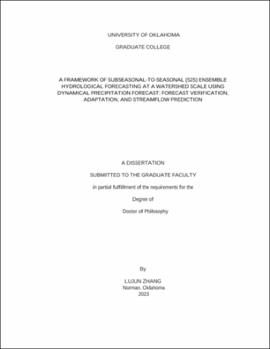| dc.contributor.advisor | Yang, Tiantian | |
| dc.contributor.author | Zhang, Lujun | |
| dc.date.accessioned | 2024-01-02T20:29:42Z | |
| dc.date.available | 2024-01-02T20:29:42Z | |
| dc.date.issued | 2023-12-15 | |
| dc.identifier.uri | https://hdl.handle.net/11244/340079 | |
| dc.description.abstract | Accurate and reliable streamflow forecasts, especially at Subseasonal-to-Seasonal (S2S) timescale (spanning 10 to 30 days into the future) could greatly benefit various human socio-economic activities. The Ensemble Streamflow Prediction (ESP) framework is commonly applied and currently in operation for streamflow predictions at S2S timescale. However, ESP’s reliance on the randomly resampled historical precipitation has limited its performance and compromised its reliability. As an alternative, the S2S precipitation forecasts derived from coupled general circulation models (GCMs) present an opportunity to overcome the limitations of randomly resampled precipitation in the ESP. Despite this potential, the application of available S2S precipitation forecasts in hydrology has not undergone a comprehensive assessment. Therefore, in this dissertation, multiple S2S precipitation forecast products from the North America Multi-Model Ensemble Phase II (NMME-2) have been collected and analyzed to validate their forecast performance over the contiguous United States (CONUS) as well as to test their hydrologic applicability at a watershed scale. The introductory chapter provides the context and outlines the research questions that motivate this dissertation (Chapter 1). A comprehensive evaluation of the performance of the raw S2S precipitation forecasts from NMME-2 over CONUS is conducted (Chapter 2). This dissertation further validates the applicability and superiority of S2S precipitation through a standard forecast adaptation technique under the ESP framework at four selected experimental watersheds (Chapter 3). In addressing the limitations of extreme precipitation event prediction, a novel Machine Learning (ML)-based post-processing technique is developed to improve the predictive skill of available S2S precipitation forecasts over CONUS (Chapter 4). This developed ML-based technique is subsequently applied to the four aforementioned watersheds, effectively adapting raw S2S precipitation for streamflow prediction within the ESP framework (Chapter 5). In conclusion, this dissertation underscores its major findings and offers insights for future research directions (Chapter 6). Through its structured exploration of available S2S precipitation forecasts from NMME-2 and their hydrological application, this dissertation contributes to advancing the field of streamflow prediction and offers recommendations for enhancing streamflow forecast accuracy and reliability. | en_US |
| dc.language | en_US | en_US |
| dc.rights | Attribution-NonCommercial-ShareAlike 4.0 International | * |
| dc.rights.uri | https://creativecommons.org/licenses/by-nc-sa/4.0/ | * |
| dc.subject | Hydrology | en_US |
| dc.subject | Streamflow Forecasting | en_US |
| dc.subject | Subseasonal-to-Seasonal | en_US |
| dc.subject | Ensemble Forecasting | en_US |
| dc.subject | Precipitation Forecasting | en_US |
| dc.title | A framework of subseasonal-to-seasonal (S2S) ensemble hydrological forecasting at a watershed scale using dynamical precipitation forecast: forecast verification, adaptation, and streamflow prediction | en_US |
| dc.contributor.committeeMember | Hong, Yang | |
| dc.contributor.committeeMember | McGovern, Amy | |
| dc.contributor.committeeMember | Kirstetter, Pierre | |
| dc.contributor.committeeMember | Kolar, Randall | |
| dc.date.manuscript | 2023 | |
| dc.thesis.degree | Ph.D. | en_US |
| ou.group | Gallogly College of Engineering::School of Civil Engineering and Environmental Science | en_US |
| shareok.nativefileaccess | restricted | en_US |

